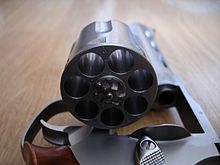Chamber (firearms)

The chamber of a firearm is the cavity at the back end of a breechloading weapon's barrel or cylinder, where the ammunition is inserted before being fired. The rear opening of the chamber is the breech, and is sealed by the breechblock or the bolt.[1][2]
Function
[edit]
The act of chambering a cartridge means the insertion of a round into the chamber, either manually or through the action of the weapon, e.g., pump-action, lever-action, bolt action, or autoloading operation generally in anticipation of firing the weapon, without need to "load" the weapon upon decision to use it (reducing the number of actions needed to discharge).[3]
Automatic and single-shot pistols (such as Derringers), rifles, and shotguns generally have a single chamber integral to their barrels, but revolvers have multiple chambers in their cylinder, and no chamber in their barrel. Thus, pistols, rifles, and shotguns can usually still be fired with the magazine removed as long as a cartridge is inserted into the chamber, while a revolver cannot be fired at all with its cylinder swung out or broken open.[citation needed]
In firearms design or modification, "chambering" is fitting a weapon's chamber for a particular caliber or round,[4] so a Colt Model 1911 is chambered for .45 ACP or .38 Super, or re-chambered for .38/.45 Clerke. While the majority of firearms are chambered for one caliber, some are chambered for multiple calibers; however firing an oversized or undersized cartridge can be hazardous.[2]
Fluted chamber
[edit]

In the barrel chamber, fluting refers to gas relief flutes/grooves used to ease the extraction of cartridges.[5][6] They may also come in annular and helical forms.[7] Notable firearms using fluted chambers are the roller-delayed blowback Heckler & Koch G3 and lever-delayed blowback FAMAS and AA-52.
Roller or lever-delayed blowback arms require that the bolt starts moving while the bullet is still in the barrel and the spent case is fully pressurized. Fluting the end of the chamber allows combustion gasses to float the neck and front of the cartridge case providing pressure equalization between the front outer surface of the cartridge case and its interior. The roller-delayed blowback StG 45(M) assault rifle prototypes proved pressure equalization fluting is desirable, since the breech of roller or lever-delayed blowback arms is opened whilst under very high internal cartridge case pressure that presses a spent (bloated) cartridge casing against the chamber walls which can cause significant problems during the cartridge extraction phase. Using traditionally cut (non-fluted) chambers in the StG 45(M) resulted in separated cartridge case heads during testing.
Ported chamber
[edit]A barrel chamber with pressure relief ports that allows gas to leak around the cartridge during extraction. Basically, the opposite of a fluted chamber, as it is intended for the cartridge to stick to the chamber wall making a slight delay of extraction. This requires a welded-on sleeve with an annular groove to contain the pressure.[8]
Multi chamber
[edit]
Mostly used on artillery guns. Multi chambered is where the barrel has a series of chambers to propel the round down the barrel to increase speed and range. The Lymann-Haskell multi chamber gun is an example.
Forensics
[edit]The chamber is a key component to the practice of forensic firearm examination. The chamber is known to imprint its surface striations irregularities on the cartridge case, in what are called chamber marks, due to the pressure produced when shooting.[9][10][11] Such imperfections in chamber may be produced in the manufacturing process or through extensive use.[12] Such chamber marks are more pronounced on substandard firearms or when firing from an undersized chamber.[9]
In recent years there has been a push to automate this process via the use of automated firearms databases.[13] Ballistics identification has also seen the development of microstamping technology which purposefully creates chamber marks through engravings on the firing pin and breech face.[14]
See also
[edit]References
[edit]- ^ Brown, Edmund G. (2009). Handgun Safety Certificate. West Sacramento, California: California Department of Justice. p. 52.
- ^ a b Walker, Robert E. (2013-03-21). Cartridges and Firearm Identification. CRC Press. ISBN 978-1-4665-8881-3.
- ^ Henshaw, Thomas (1993). The History of Winchester Firearms 1866-1992. Winchester Press. ISBN 978-0-8329-0503-2.
- ^ Ramientas, Mike (2020-08-18). ".25-06 Remington vs. .243 Winchester: The Better Overbore -". Gun News Daily. Retrieved 2020-09-01.
- ^ "Firearm barrel having cartridge chamber preparation facilitating effiecient cartridge case extraction and protection against premature bolt failure".
- ^ "Punch for fluting gun-barrel chambers".
- ^ Krcma, V., "Fluted and Annular Grooved Barrel Chambers in Firearms," Journal of Forensic Sciences, JFSCA, Vol. 41, No. 3, May 1996, pp. 407-417.
- ^ "Firearm barrel assembly with ported chamber".
- ^ a b Sinha, J. K. (2014-11-07). Forensic Investigation of Unusual Firearms: Ballistic and Medico-Legal Evidence. Taylor & Francis. ISBN 978-1-4665-7137-2.
- ^ Monturo, Chris (2019-06-15). Forensic Firearm Examination. Elsevier Science. ISBN 978-0-12-814540-1.
- ^ Siegel, Jay A.; Mirakovits, Kathy (2015-12-01). Forensic Science: The Basics, Third Edition. Taylor & Francis. ISBN 978-1-4822-5337-5.
- ^ Wheeler, Barbara; Wilson, Lori J. (2011-08-10). Practical Forensic Microscopy: A Laboratory Manual. John Wiley & Sons. ISBN 978-1-119-96557-2.
- ^ "Mission". www.geneva-academy.ch. Retrieved 2020-09-01.
- ^ Page, Douglas (January 1, 2008). "Microstamping calls the shots: a revolutionary gun identification technology finds favor and foes". Vol 35, Issue 1. Law Enforcement Technology. Archived from the original on 2014-06-29. Retrieved 2020-09-02.
External links
[edit]- Chamber Archived 2016-03-15 at the Wayback Machine
